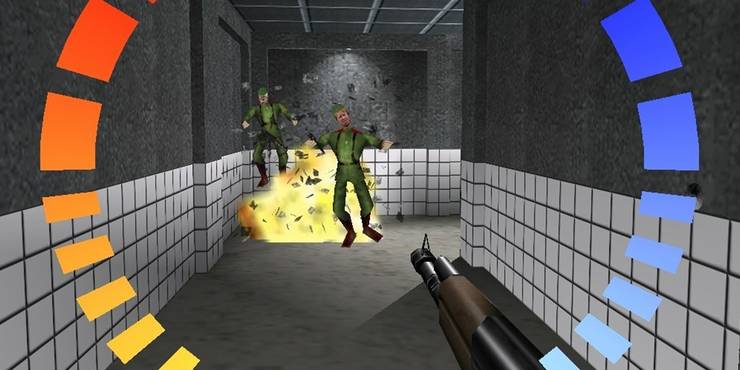The 10 Best Arena-Based First Person Shooter Games, According To Metacritic

Arena-style FPS games are hard to classify, but they are typically associated with fast-paced, high-octane gameplay and weaponry. In order to succeed, players had to possess natural talent and acquired kill, which would allow them to climb the ranks and achieve bragging rights. This type of FPS shooter managed to detach itself from elements that could influence the outcome of a battle, such as the strength and skill of a team.
Those who mastered the wildness of an arena FPS bout emerged stronger for it, which was part of the genre’s allure and charm. Metacritic has ranked the best arena FPS shooters over the last few decades, all of which have influenced, and continue to influence, the evolution of the genre.
10 Counter-Strike: Global Offensive (83)

With an ocean of players and one of the most robust and beloved combat systems in FPS gaming, Counter-Strike: Global Offensive has become something of a cultural phenomenon. It’s exceptionally difficult to master, especially given just how many veterans continue to nuke the online play field on a regular basis.
CS:GO took everything from previous Counter-Strike titles, while broadening out the concept of an arena-style shooter to create one of the flagship properties in the genre. Almost a full decade later, it continues to soldier on as one of the most prolific of the bunch.
9 Tribes Ascend (86)

Tribes was considered an early precursor to arena style FPS games in the 1990s, and it made quite an impact during that time period. In 2012, Hi-Rez Studios decided to resurrect the franchise with the latest entry, Ascend, a free-to-play title with expanded gameplay elements.
The series is best known for utilizing jetpacks for aerial combat, creating a new vertical space through which players could fight. Though Ascend scored high with critics, it didn’t quite meet the same level of critical and iconic success as the original games.
8 Doom (87)

The 2016 reboot of Doom took all of its cues from classic arena FPS shooters like Quake III: Arena and Unreal Tournament, forging an entirely new, yet strangely familiar dynamic. Doom required fast reflexes and adaptability to stay alive, which was no small feat.
With so much being thrown at the player at any given moment, snap decisions were a must, as was the ability to harness the devastating arsenal of devastating and over-the-top Doom weapons. Pit it side-by-side against Quake III: Arena, and it’s obvious where the bulk of the inspiration came from.
7 Apex Legends (89)

This large-scale arena FPS game takes place in the Titanfall universe, but its battlefields are much larger and more drawn out, requiring teams to work together more efficiently. In terms of play mechanics, it has more in common with battle royale games like Fortnite, but its roots in arena combat are evident.
The wide open maps scale back the frantic shootouts a bit, but once the bullets start flying, Apex Legends shows its true colors. It manages to straddle a classic era, and a modern one, creating a comfortable, albeit imperfect mixture of the two. Ironically, it’s also a game that causes players to swear and curse quite a lot.
6 Timesplitters 2 (90)

The Timesplitters series originally debuted on the PlayStation 2 as a spiritual successor to Rare’s GoldenEye and Perfect Dark titles for the N64. The combat was a lot more fast-paced and frantic, which fit well with the buttery smooth 60fps gameplay.
In terms of overall approach, Timesplitters doesn’t really differentiate itself from its DNA predecessors, but the second chapter in the series did provide one of the best arena-style FPS experiences of the period. It’s also a shoo-in for a video game property that could easily be turned into a Christopher Nolan movie.
5 Overwatch (91)

Overwatch could be considered one of the last great arena FPS titles, dropping right before Fortnite’s battle royale formula took the world by storm. It has a large following, thanks in part to a roster of excellent characters, a host of of dynamite maps, finely-tuned FPS mechanics, and dazzling visuals.
Though it would later be overshadowed by competitors like Fortnite, Overwatch did manage to hold its own for a significant period of time. These days, it still has a diehard fan base, thanks in large part to how well it adopts and implements the arena FPS formula.
4 Quake III: Arena (93)

When Quake III: Arena debuted, it gave audiences an entirely new experience within the existing franchise framework. A single-player campaign mode was given the chop in favor of a straight-up arena FPS experience, leveraging arcade-style gameplay with a dystopic American Gladiators feel.
It was the game that truly immortalized concepts like the rocket jump, adding them into the official FPS lexicon. It would eventually get overshadowed by Unreal Tournament, but it could very well be considered the granddaddy of the arena FPS genre.
3 Unreal Tournament 2004 (93)

Unreal Tournament stood in direct competition to Quake III: Arena, debuting one month prior to that game. At first glance, the two games appeared very much alike, but Unreal Tournament leveraged the world built by the original Unreal FPS game, which set it apart.
The second entry in the franchise came in 2004, and was a marked improvement in every way. Unreal Tournament 2004 is one of the most pure and untainted arena FPS games ever made, and helped reshape the entire definition of the genre as game development moved forward.
2 Goldeneye (96)

When Rare debuted GoldenEye 007 on the N64 as a tie-in property to the James Bond film of the same name, it was doubtful they had any idea just how successful it would become. It soon became the talk of the town, thanks in large part to a robust 4-player multiplayer system that drove fans wild.
GoldenEye was far from a perfect game, but its signature control scheme, weapon mechanics and split screen arena FPS gameplay made it a surefire hit. It was responsible for turning the N64 into a powerhouse competitor, at a time when companies like Sony were only just beginning to lay down their roots.
1 Perfect Dark (97)

Not to be outdone by the success of GoldenEye, Rare immediately began work on a spiritual follow-up that utilized the same engine, and the familiar play mechanics of the previous title. It then set about tinkering with the gameplay elements to expand and enhance on everything that had come before.
Perfect Dark was an original story set in a self-contained universe, but for arena FPS fans, it was simply GoldenEye on steroids. It was an apt comparison, since Perfect Dark took every single facet of the 4-player split screen formula, and juiced them up to the nth degree.
About The Author

















